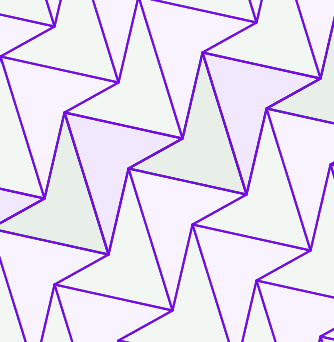Covering the plane with an unlimited supply of identical tiles is called tiling the plane, or tessellation. You can use one or more initial shapes, and you must have a convincing argument that your pattern can extend infinitely in all directions.
Tiling provides many opportunities in the classroom, as it illustrates basic geometry concepts, and offers opportunities for mathematical exploration and discussion. Student engagement is nearly guaranteed, the opportunities for creativity abound, and student work can be displayed on bulletin boards or online. I share some arguments for why tiling belongs in the classroom in this blog post. Likewise in Geometric Puzzles for Prospective Math Teachers.
Here are links to tiling activities and tools on this site:
In Geometry Labs:
- Section 7 is all about tessellation: Tiling with Polyominoes, Tiling with Pattern Blocks, Tiling with Triangles and Quadrilaterals, Tiling with Regular Polygons. The last two are very "curricular", in that they address topics central to secondary school geometry.
- My Geometry Labs template is ideal for exploring tiling with triangles and quadrilaterals (Lab 7.3), and regular polygons (Lab 7.4). Check it out here. Purchase it here.
- Section 10 includes material on tiling finite figures. Different version of Lab 10.4: Rep-Tiles.
- Section 11 includes the final lab in the book, which uses a pattern block tiling in a lesson about "π" for regular polygons.
After Lab 7.3, you can show or share these GeoGebra files: Tiling Triangles | Tiling Quadrilaterals
Wallpaper Starters is a challenging puzzle-like activity which combines symmetry and tiling. The idea is to extend the given pattern, using the given mirror lines as the only guide.
If you create more pattern block wallpaper starters, I will post them here and credit you.
Wallpapers Catalog, using pattern block tilings
If you use the Notebook software for the SmartBoard, you can explore tiling with this document. (Includes clonable pentominoes, pattern blocks, triangles, quadrilaterals, and regular polygons.)
In Polyomino Lessons, the section on tiling includes specific challenges on grid paper, or perhaps Virtual Grid Paper.
Zome Geometry, the book I co-authored with George Hart, has a section on tiling, including activities about dual tessellations, spiral tilings, and non-periodic tilings.
